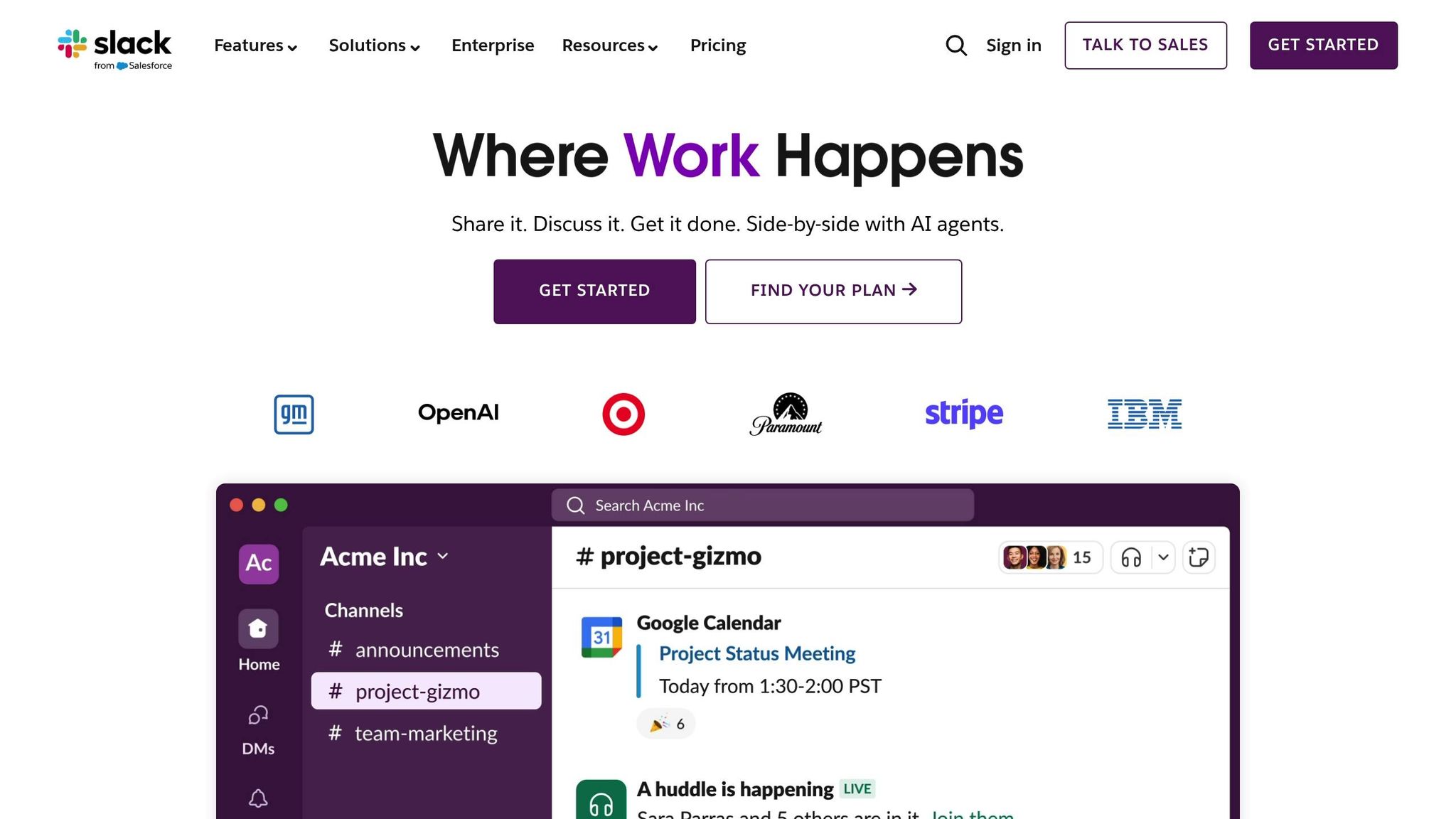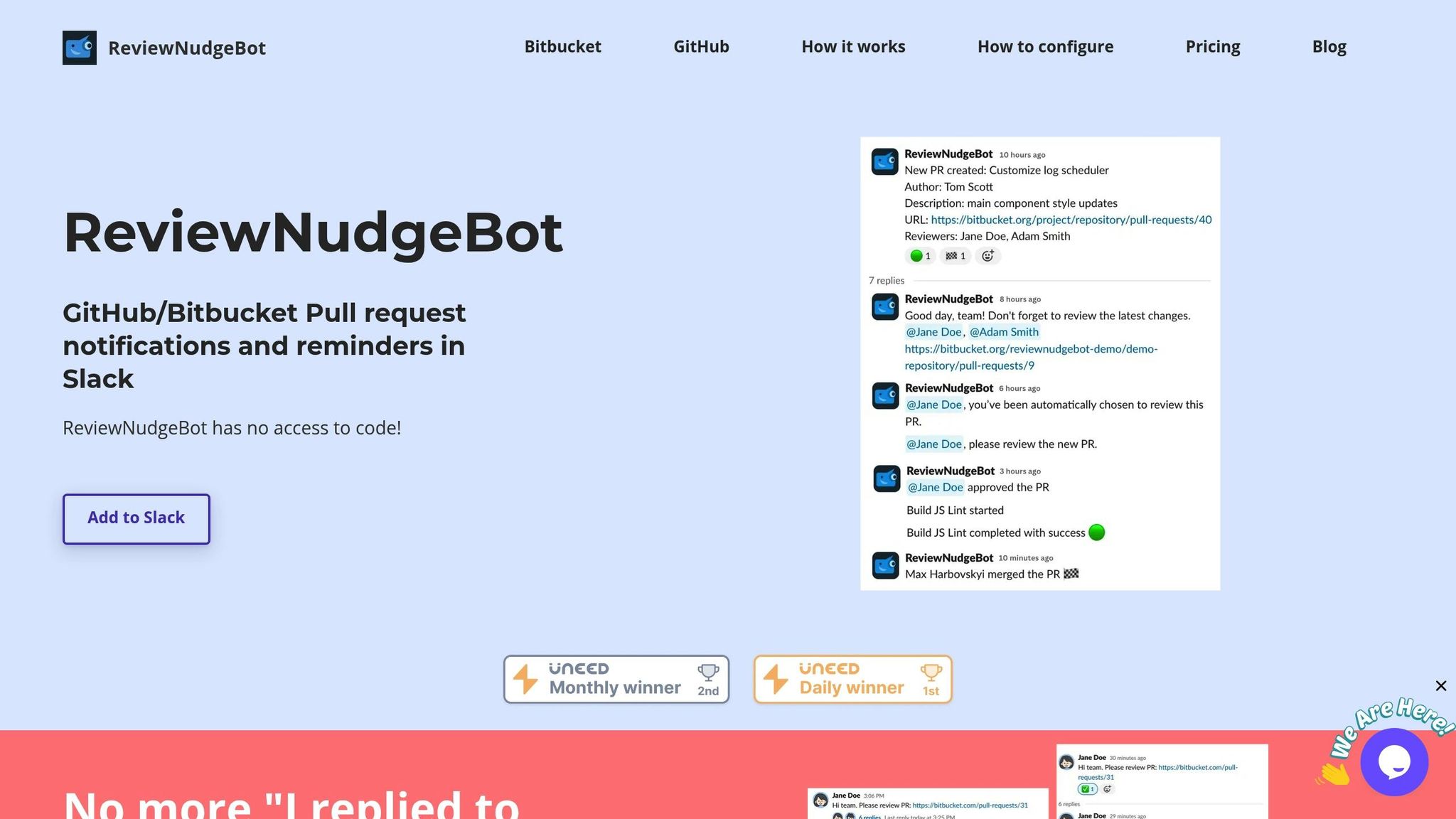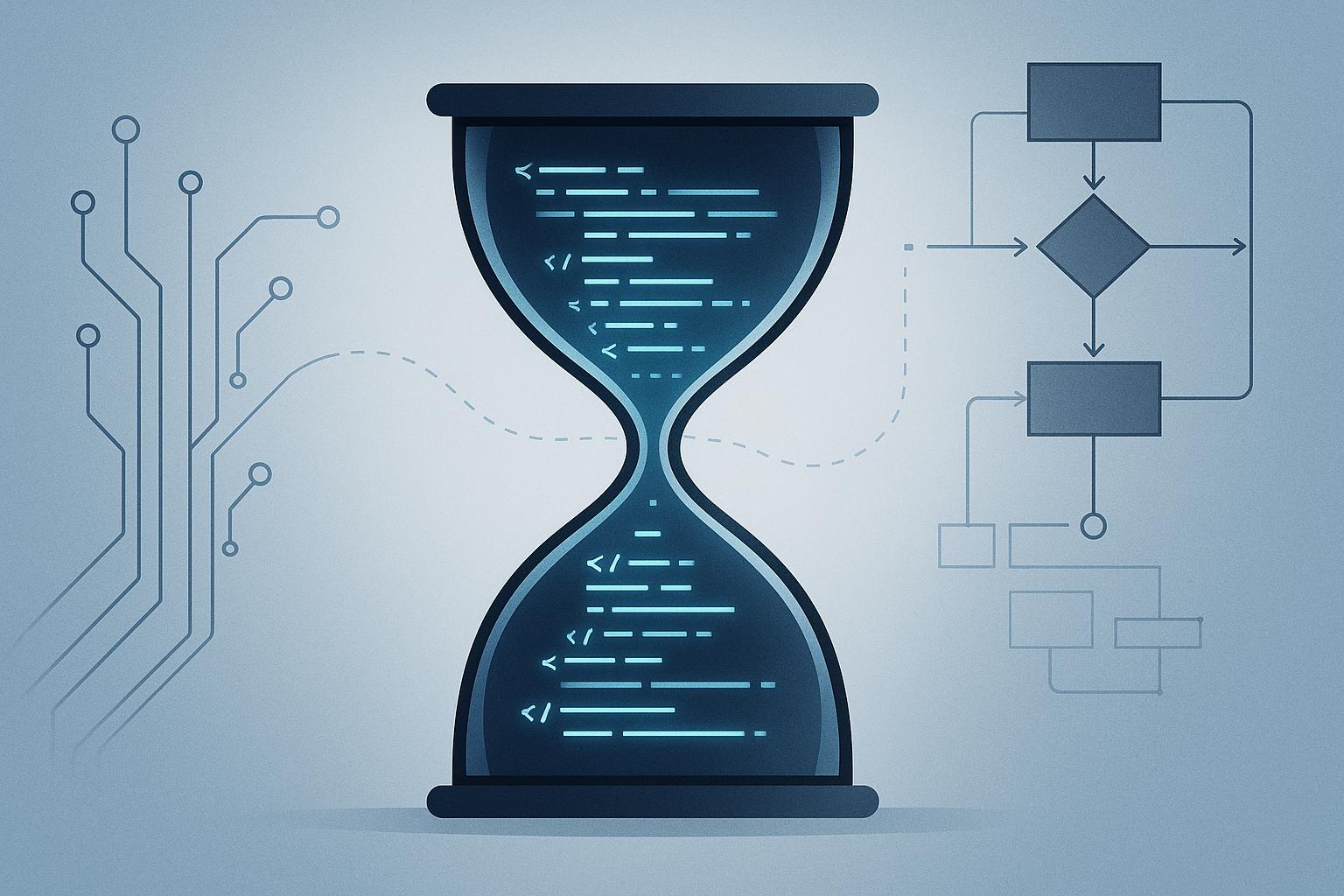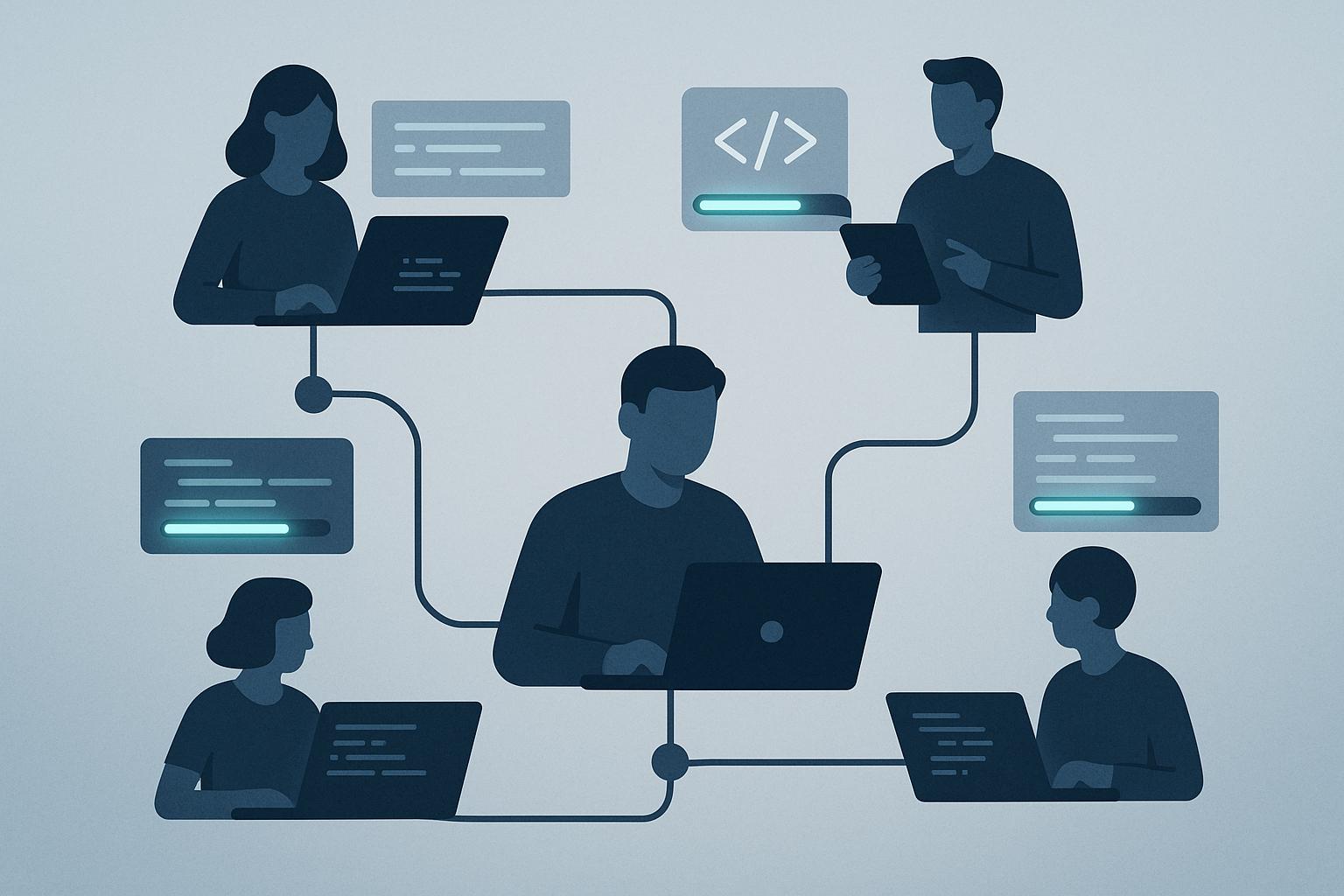Distributed software teams often struggle with productivity due to communication barriers, time zone differences, and workflow inefficiencies. This article explores how workflow awareness and clear goal-setting can help remote teams work more effectively. Here's what you need to know:
- Workflow Awareness: Real-time insights into team progress and bottlenecks can reduce interruptions by 46% and improve decision-making.
- Goal-Setting: Aligning individual and organizational goals boosts efficiency by 35% and keeps remote teams focused.
- Tools and Automation: Integrating Slack with tools like ReviewNudgeBot automates code reviews, saving time and reducing delays by up to 60%.
- Challenges in Remote Work: Communication gaps, cultural differences, and time zone constraints can hinder collaboration but can be addressed with unified tools and clear protocols.
Improving Collaboration with Slack and Code Review Automation

Building on clear team goals and improved workflow awareness, integrating Slack with automated code review tools can make collaboration smoother and more efficient. Distributed teams need more than just communication platforms - they need smart automation that keeps everyone in the loop without overwhelming them. By combining Slack integrations with automated code review processes, teams can reduce manual tasks, improve transparency, and avoid delays. Here’s how Slack and automation tools work together to streamline development workflows.
Using Slack for Real-Time Communication
Slack isn’t just a messaging app - it serves as a central hub for development teams. Its real strength comes to light when it’s integrated with code review workflows. Instead of relying on clunky email notifications or constant manual updates, teams can use Slack's threading features to create focused discussions around specific pull requests.
Customizing Slack notifications makes a big difference. Teams can set keyword alerts or channel-specific threads to manage updates without overwhelming their developers. Dedicated channels for code reviews ensure that important requests don’t get lost in general conversations, while also promoting transparency throughout the review process.
Automating Manual Tasks with ReviewNudgeBot

Coordinating code reviews manually can be a major hurdle, especially for distributed teams working across different time zones. That’s where ReviewNudgeBot comes in - it automates many of the tedious parts of the review process, saving time and reducing friction.
The bot automatically assigns reviewers, balancing workloads and preventing some team members from being overloaded. It also tracks the lifecycle of pull requests, using messages and emoji updates to mark key events like approvals, rejections, change requests, merges, or declines. This provides a clear, high-level overview of the team’s progress without requiring constant manual updates.
ReviewNudgeBot has been shown to cut code review times by 60%. Teams typically deploy it in Slack and connect it to GitHub for seamless review tracking.
Setting Up Custom Notifications for Team Awareness
Beyond automating assignments, fine-tuning notification strategies can further enhance team awareness. ReviewNudgeBot includes features designed to keep everyone informed without creating unnecessary noise.
- Threaded Notifications: Group pull request updates into threads to keep the main Slack channel clean and organized.
- Escalation Reminders: If a pull request sits idle for too long, the bot automatically alerts team leads or project managers to ensure it gets attention.
- Priority Alerts: Highlight critical pull requests, like hotfixes or security patches, keeping them visible until resolved.
The bot also simplifies comment tracking by posting updates when new comments are added, replies are made, or issues are resolved. Developers can even pause specific notifications with simple reactions, giving them control over what they see.
These automation tools create an environment where team members can stay informed about important updates while maintaining focus on their work. The result? A more collaborative and responsive development process that works well for distributed teams. With streamlined notifications and precise tracking, teams can stay on top of their goals and keep projects moving forward efficiently.
Connecting GitHub and Bitbucket with Slack for Better Reviews

Linking your GitHub or Bitbucket repositories to Slack can completely change the way development teams handle code reviews. By integrating these tools, pull request updates are automatically shared in Slack, which simplifies workflows and keeps projects moving. This setup encourages secure, automated reviews while improving team communication.
Setting Up Webhook Connections
Webhooks are the key to automating repository updates in Slack. With the Pro Plan from ReviewNudgeBot, webhook integration becomes seamless, removing the hassle of manually sharing URLs. On the Free or Plus plans, the bot activates when version control system URLs are shared in public Slack channels. By adding a webhook to your GitHub or Bitbucket repository, events like pull request creation, approval, or closure are automatically posted in Slack, making the review process smoother and more efficient. This automation reduces the need for manual updates and keeps the focus on reviewing code.
Key Features for Secure and Fast Code Reviews
Security is critical for any integration, and ReviewNudgeBot takes this seriously. It never accesses your actual repository code - it simply reads webhook events. The integration also tracks pull request progress using simple emoji updates, while build status notifications provide teams with CI results, helping them address issues quickly.
According to research, teams that use this approach see a 60% reduction in pull request lifetimes across 8,500 teams. For added flexibility, team members can adjust notification frequency by reacting with specific emojis to dismiss reminders for individual pull requests. These features ensure that code reviews remain both efficient and secure.
Improving Transparency with Comment Notifications
Delayed feedback can stall distributed code reviews, but real-time comment tracking solves this problem. Whenever reviewers leave comments or request changes, the integration instantly notifies the right people in Slack, speeding up the feedback process.
The system also tracks comment activity, sending notifications when comments are added, replied to, or resolved. It keeps developers on track with reminders about pending comments, failed builds, or requested changes. If pull requests remain stuck, escalation reminders alert team leads or project managers, ensuring nothing slips through the cracks. By combining comment notifications with workflow updates, teams can improve both transparency and responsiveness, keeping everyone aligned without extra coordination across multiple tools.
Best Practices for Faster Pull Request Reviews
Slow code reviews can stall development progress. In fact, 44% of development teams cite sluggish reviews as their biggest delivery bottleneck. By adopting focused strategies, teams can speed up the review process without compromising code quality.
Research-Driven Tips for Code Reviews
The size of pull requests (PRs) plays a major role in review efficiency. Teams working with PRs averaging around 50 lines of code deliver 40% more output than those handling PRs over 200 lines. Smaller PRs are easier to digest, review thoroughly, and merge with minimal conflicts.
Timing is another critical factor. When pull requests sit idle for more than 48 hours, developer engagement drops by 32%. Successful teams often follow a "review first" approach, starting their day by addressing pending PRs before diving into new code. This habit keeps workflows smooth and ensures timely feedback, fostering a more productive environment.
Providing context within pull requests also makes reviews faster and more effective. Developers should include clear, descriptive titles and detailed explanations. Explaining why changes were made, highlighting potential impacts, and pointing out areas needing attention can significantly reduce review cycles. For instance, teams that average 1.1 review cycles per PR outperform the typical 1.2 cycles.
Setting Clear and Measurable Review Goals
Top-performing teams set concrete goals for reviews. For example, Google's engineering guidelines recommend responding to code review requests within one business day. This practice ensures prompt feedback and keeps the development pipeline moving.
Some key goals include:
- Completing the first review of a PR within 24–48 hours of submission.
- Ensuring critical code paths are reviewed by at least two developers.
- Verifying that builds pass automated checks before human reviews begin.
Dedicating just 30 minutes daily to reviewing PRs can significantly boost team efficiency. To measure progress, teams should track metrics like average review time, number of review cycles per PR, and the percentage of PRs requiring multiple rounds of feedback. These insights can help identify bottlenecks and improve overall performance. Automation tools can further streamline this process.
Leveraging ReviewNudgeBot for Better Workflow
ReviewNudgeBot simplifies goal tracking and ensures timely reviews by automating key steps. With its features, teams can meet review time targets and minimize delays. On average, poor review workflows cost developers 5.8 hours each week.
This tool also helps catch issues early, allowing human reviewers to focus on higher-level concerns like code design and maintainability. By integrating real-time communication and automated comment tracking, ReviewNudgeBot fosters collaboration and accelerates review cycles, helping teams stay on track and improve their output.
sbb-itb-7c4ce77
Goal-Setting Strategies for Remote Development Teams
Remote development teams often navigate unique hurdles when it comes to setting and achieving goals. Without the benefit of face-to-face interaction, it takes intentional strategies and the right tools to ensure everyone’s contributions align with team and company objectives.
Using SMART Goals for Development Teams
The SMART framework is a practical way for remote teams to create clear, actionable objectives. SMART stands for Specific, Measurable, Achievable, Relevant, and Time-bound - elements that help distributed teams focus their efforts on meaningful outcomes. For example, developers might aim to reduce load times to improve user experience. Breaking down larger goals into smaller, trackable tasks makes progress easier to measure and manage. Transparent communication is key here - everyone on the team should understand the objectives. Digital tools can bridge gaps caused by time zones and differing work styles, ensuring clarity and collaboration. To make SMART goals work, teams need to openly discuss roles, resources, and timelines so everyone stays on the same page. These well-defined goals serve as a foundation for tracking progress and ensuring alignment.
Tracking Progress with Automated Metrics
Once SMART goals are in place, automated metrics can provide real-time insights to keep teams on track. Manual tracking is often too time-consuming for remote teams, but automated tools streamline the process by monitoring key metrics like cycle time, deployment frequency, and review efficiency. These tools not only save time but also help developers focus on what matters most. For instance, organizations with highly engaged teams have seen a 21% boost in profitability. Tools like ReviewNudgeBot keep everyone informed by monitoring pull request lifecycles and build statuses, sending alerts when action is needed. By prioritizing results over hours worked, these systems promote efficiency and accountability. Technology-driven accountability frameworks also encourage open communication and help teams address roadblocks before they escalate.
Aligning Team Goals with Business Objectives
Measuring progress is just the first step - aligning team efforts with broader business goals is where the real impact happens. This alignment starts with translating company-wide objectives into clear, actionable goals for the team. Managers play a critical role here by communicating these objectives and explaining their importance to keep remote teams motivated. Tools like project management software can break down big-picture goals into smaller tasks, assign responsibilities, and track progress in real time. ReviewNudgeBot can also provide insights into code review trends, collaboration patterns, and bottlenecks, helping managers make informed adjustments to workloads. To ensure success, teams need the right tools, training, and resources. And don’t underestimate the power of celebrating small wins - acknowledging achievements, even virtually, can go a long way in boosting morale when face-to-face recognition isn’t possible.
Manual vs. Automated Code Review Processes: A Comparison
In the world of software development, the choice between manual and automated code reviews can shape how teams maintain efficiency and code quality. Understanding the strengths and limitations of each approach is crucial for optimizing workflows.
Manual code reviews have long been considered the benchmark for quality control. They rely on experienced developers meticulously analyzing code to evaluate its context, business logic, and architecture. This method shines when it comes to spotting complex vulnerabilities or ensuring that code aligns with specific requirements. However, the downside is clear - manual reviews are time-intensive, costly, and can slow down fast-paced development cycles, creating potential bottlenecks.
On the other hand, automated code reviews - such as those powered by tools like ReviewNudgeBot - bring a different kind of efficiency to the table. These systems leverage predefined rules to quickly scan code, flag issues, and even manage the review process through integrations with platforms like Slack. While automation doesn't replace the nuanced judgment of a human reviewer, it simplifies communication, assigns tasks, and tracks progress, addressing many of the delays typical of manual workflows.
The benefits of automation are backed by data. For instance, teams using static analysis tools report a 37% drop in inconsistent feedback during reviews. Similarly, those incorporating automated code reviews have seen a 25% to 30% reduction in bugs after code merges. ReviewNudgeBot, in particular, has been shown to cut code review time by an impressive 60%.
A core difference between the two methods lies in how they handle communication. Manual reviews depend on developers to manually check for new pull requests, assign reviewers, and follow up on progress. This often leads to delays, uneven workloads, and overlooked tasks. In contrast, automated tools like ReviewNudgeBot streamline these processes. They send reminders, ensure fair reviewer assignments, and escalate stalled pull requests automatically - tasks that would otherwise require significant manual effort.
The following table highlights the contrasts between manual and automated code reviews:
Comparison Table: Manual vs. Automated Processes
| Feature | Manual Code Review | Automated Code Review (with ReviewNudgeBot) |
|---|---|---|
| Speed | Slow, time-consuming for large codebases | Fast, scans extensive codebases in minutes |
| Communication | Relies on manual notifications | Automated reminders and Slack notifications |
| Reviewer Assignment | Manual, often uneven | Automatic, ensures balanced distribution |
| Context Awareness | High, considers intent and purpose | Limited to syntax and patterns |
| Consistency | Varies by reviewer | Systematic, applies rules uniformly |
| Escalation | Manual escalation | Automated for stalled pull requests |
| Status Tracking | Requires checking multiple sources | Updates integrated into Slack threads |
| Cost | Higher, relies on skilled labor | Lower per scan, better return on investment |
| Error Detection | Catches complex vulnerabilities | Focused on common, known issues |
| Integration | Limited with communication tools | Seamless with Slack, GitHub, Bitbucket |
| Scalability | Challenging for large teams | Easily scales with team size |
| False Positives | Rare, human validation | More frequent, needs human follow-up |
Given these differences, many teams find that a hybrid approach offers the best of both worlds. Automated tools can handle repetitive tasks - like scanning for common issues, managing communications, and tracking progress - while human reviewers focus on evaluating complex logic, architectural choices, and alignment with business goals. This combination ensures efficiency without sacrificing the nuanced insights that only experienced developers can provide.
That said, some teams hesitate to adopt automation due to concerns about losing control or dealing with false positives. Yet, studies show that 36% of companies believe code reviews are the most effective way to improve code quality. The key to success lies in implementing automation thoughtfully, ensuring it complements rather than replaces manual practices, and gaining team buy-in for the transition.
Conclusion: Building Long-Term Productivity with Awareness and Goal-Setting
Achieving lasting productivity in distributed teams hinges on consistent improvement and clear alignment. The strategies outlined in this article lay the groundwork for creating high-performing development teams that can navigate the challenges of remote work while embracing tools that streamline their workflows.
Key Takeaways for Managers
Managing remote teams effectively requires a shift in how productivity and communication are approached. Awareness and goal-setting aren't optional - they're essential for keeping teams aligned and on track. With 55% of remote workers facing communication and collaboration challenges, thoughtful management practices become critical.
The best managers understand that true productivity stems from refining workflows, equipping teams with the right tools, and fostering a supportive environment. As Oscar Ganuza, General Manager PSS Europe, LATAM, APAC & META at Honeywell, explains:
"Remote work isn't just convenient - it's the new norm. But staying connected, aligned, and productive takes a lot of intentionality."
SMART goals - Specific, Measurable, Achievable, Relevant, and Time-bound - offer a clear framework for this intentionality. By involving the team in setting these goals and regularly reviewing progress, managers can ensure alignment with broader business objectives.
Reducing developers' cognitive load is another cornerstone of productivity. Automating repetitive tasks, cutting unnecessary meetings, and providing clear guidelines allow developers to focus on solving complex problems. When administrative burdens are minimized, productivity naturally improves.
Effective communication and transparency are equally important for remote teams. Beyond using the right tools, this means fostering an environment where team members feel comfortable sharing ideas and feedback. Regular check-ins, clear updates, and defined communication channels help information flow smoothly. Automation tools can further enhance these practices by handling routine tasks and freeing up time for more meaningful collaboration.
How ReviewNudgeBot Supports High-Performing Teams
ReviewNudgeBot addresses common challenges that slow down team performance, particularly in code review processes. By automating manual communication tasks, it allows developers to focus on their core work - writing great code and tackling complex problems.
The tool’s impact goes beyond speed; it creates a more sustainable workflow by reducing the mental load of managing pull requests and reviewer assignments. Its automation capabilities align seamlessly with SMART goal principles, offering automated reminders, fair workload distribution, and escalation for delayed tasks. This ensures visibility and accountability within the team.
Amy Reichert, Professional QA Tester and Writer, highlights the importance of developer support when adopting tools:
"For any tool, the most critical factor is the level of developer support."
ReviewNudgeBot succeeds by integrating with existing workflows rather than disrupting them. With integrations for Slack, GitHub, and Bitbucket, developers can continue working in their preferred environments while benefiting from improved coordination and communication.
Goal tracking and progress monitoring are at the heart of ReviewNudgeBot’s design. By providing metrics on review times, workload balance, and pull request lifecycles, it equips managers with the data they need to set realistic goals and measure progress objectively. This data-driven approach enables teams to refine workflows, identify bottlenecks, and maintain consistent productivity.
FAQs
How does integrating Slack with automated code review tools like ReviewNudgeBot boost collaboration in remote software teams?
Integrating Slack with automated code review tools such as ReviewNudgeBot can significantly enhance collaboration for remote software teams. By sending real-time updates and notifications straight to Slack channels, it eliminates the need to juggle multiple platforms, ensuring everyone stays on the same page.
This setup simplifies communication, encourages quick discussions, and helps minimize delays in the review process. The result? Faster decisions, better alignment, and a boost in productivity for distributed teams - all without adding unnecessary complexity.
How can SMART goals improve productivity and align remote development teams with business objectives?
SMART goals are a powerful tool for remote development teams, offering clear direction, measurable targets, and a practical framework for reaching objectives. They help team members stay on track with priorities that truly matter, driving both efficiency and motivation.
By connecting individual and team efforts to overarching business objectives, SMART goals encourage stronger teamwork and a unified sense of purpose. This level of clarity enables remote teams to work more effectively, ensuring their efforts make a meaningful impact on the organization’s success.
How does ReviewNudgeBot improve the code review process and boost team productivity?
ReviewNudgeBot takes the hassle out of the code review process by sending automated reminders, cutting down delays by about 12%. This means developers can spend more time on meaningful discussions and actual coding, instead of constantly checking the status of pull requests.
By streamlining workflows and reducing manual effort, ReviewNudgeBot promotes smoother collaboration and speeds up review cycles. The result? Better code quality and improved team productivity - especially crucial for remote or distributed teams.


